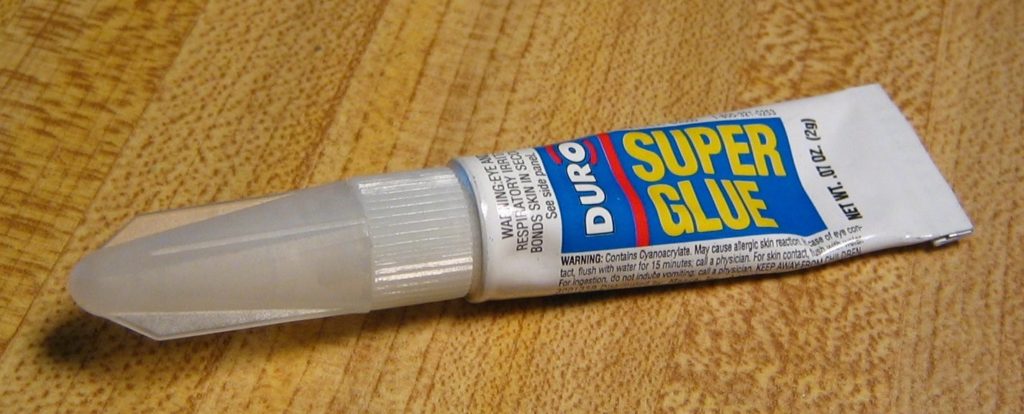
I learned this today. Superglue works because a chemical reaction occurs that makes it harden.
Superglue is made from ethyl cyanoacrylate, which is an acrylic resin. Cyanoacrylate hardens when it comes into contact with water. Cyanoacrylate is an acrylic monomer. A monomer is a molecule that can react together with other monomer molecules to form a larger polymer chain. The other molecules that cyanoacrylate reacts with are water (hydrogen and oxygen). When the cyanoacrylate reacts with the molecules of water, (specifically the hydroxide ions) they form long, strong polymer chains, that are basically plastic. The cyanoacrylate molecules move around freely, which is why they stay in their liquid form in the tube, but on contact with water, they gradually form a durable plastic mesh.
Cyanoacrylate only needs a small amount of water to start the chemical reaction and there is usually moisture on everything, even the glass you are trying to glue together. This is because there is water in the air. The air around us always has a certain level of moisture in it and this is the humidity level. It is impossible to get zero humidity, so there is always water available. The lowest ever recorded humidity on Earth was 0.36% at Safi-Abad Dezful, in Western Iran, on June 20, 2017. It is impossible to get zero humidity because water is always evaporating from the things around us into the air.
Regular glue has water in it and it works by evaporation. As the water evaporates, the glue becomes harder until it completely cures and sticks the two surfaces together. This is why normal glue takes a long time to set. It literally has to “dry”. Super glue reacts with the water, creates heat, and sets almost instantly. This is why it always comes with warnings on the packet. You can very easily stick your fingers together.
Superglue was invented in the 1950s and is actually a brand name. The properties of cyanoacrylate were discovered in 1942 by Dr. Harry Coover. He was working for Eastman-Kodak. He was tasked with trying to make clear plastic gun sights during World War 2. A clear gun sight would make aiming easier, they thought. The cyanoacrylate stuck to everything they used and made it very difficult to work with. It was deemed too sticky to be useful.
In 1951, Coover was transferred to Kodak’s chemical plant. He was working with a group of chemists to make heat-resistant polymers for jet canopies. He remembered the cyanoacrylate and they tested it. During the testing, he realized that it would stick to almost anything without needing heat or pressure to bond. He saw a use for it.
He patented it and Kodak started to sell it in 1958. It wasn’t called Super Glue until a few years later.
Superglue has many uses, and there is a rumor that it was used to close up wounds in World War 2. This obviously can’t be true because it wasn’t invented until over ten years after the war had finished. However, it was actually used to close up wounds during the Vietnam War. Medics would spray it over an open wound, and it would stop the bleeding, allowing the injured soldier to be transported to a hospital. There are no figures on how many lives it saved, but it certainly did prevent a lot of deaths.
Superglue (cyanoacrylate) is used in the medical industry to this day. Super glue is a common alternative to stitches after an injury. It can be safer and more functional. Stitching is painful and can take a long time. Super glue can help the wound close faster and it seems to lower the cases of infection. Stitches put holes into the skin that go down into the deeper layers that can be a path for contamination. Super glue seals the wound shut without this problem. Also, stitches can leave scars that super glue doesn’t. Once the wound is healed, in time, the super glue will be shed as the skin naturally sheds and regenerates itself.
If you do happen to stick your fingers together with superglue (as I have done more often than an adult should admit to), it can be dissolved with acetone. Acetone is an organic compound that is a very effective solvent. It can break down the polymers and dissolve superglue.
So, superglue works because the molecules in the cyanoacrylate bond with the water in the atmosphere, becoming a hard plastic. And this is what I learned today.
Image by CC BY-SA 3.0, https://commons.wikimedia.org/w/index.php?curid=640168
Sources:
https://www.wonderopolis.org/wonder/how-does-super-glue-work
https://home.howstuffworks.com/question695.htm
https://www.hotmelt.com/blogs/blog/what-is-cyanoacrylate-glue
https://www.sciencefocus.com/science/how-does-super-glue-work/
https://en.wikipedia.org/wiki/Cyanoacrylate
https://en.wikipedia.org/wiki/Monomer
https://gunthertoodys.com/1950s-inventions-superglue/
https://lemelson.mit.edu/resources/harry-coover
